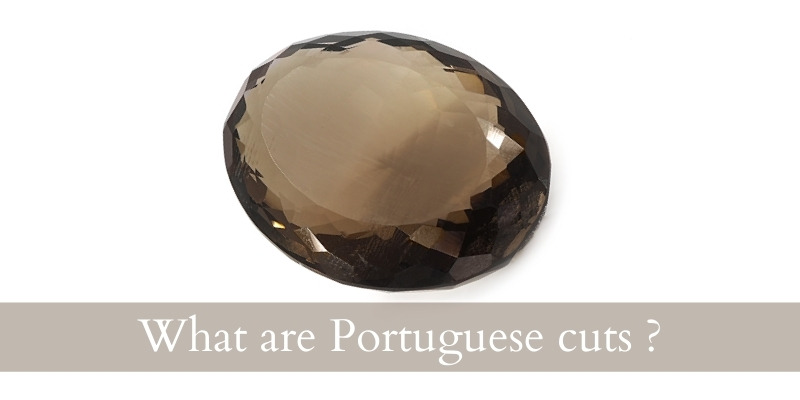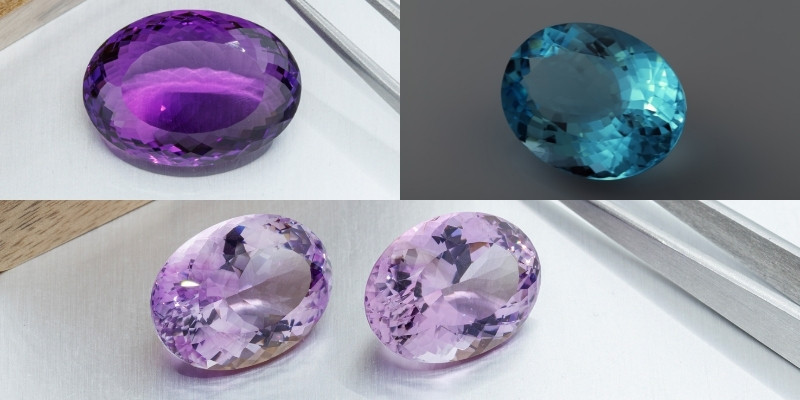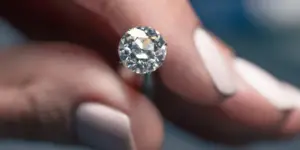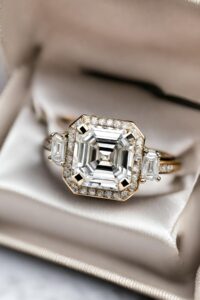In the world of gemstones anything is possible, including cut style that you may not have heard of. We all know the classic round brilliant, but what if you’re looking for something in a round shape but with a little more oomph ? This is where the Portuguese cut comes in. Brilliant, mesmerizing, difficult to master and just as difficult to find on the market.
But it’s a truly stunning gemstone cut and it’s definitely something to consider if you want your jewelry to be out of the ordinary and make people look twice. So let’s take a look at what a Portuguese cut is, and the key points you need to know when looking for such a gem.

What is a Portuguese cut ?
A Portuguese cut is a fancy brilliant cut where the pavilion features 3 rows of triangular facets while the crown features 2 rows of diamond-shaped facets. The result is a very brilliant gemstone with lots of scintillation that works best for light to medium-light gemstones.
A standard Portuguese cut has 161 facets, a large table, very high pavilion, and a higher-than-average crown. The crown to pavilion ratio may change from gem to gem but overall this style of cut is always taller than a standard round brilliant. Portuguese cuts have a very generous table and various shapes are possible such as oval, pear, round, and so on. Check the image below for examples of a typical Portuguese cut.

Next we’ll discuss the key features of a Portuguese cut. These should give you enough information to know what to look for when sourcing a Portuguese cut gem, and whether this is a good option for you or not.
1. Portuguese cuts work best for large gemstones
Portuguese cuts are highly brilliant, so it’s because of this we recommend you get a gemstone at least 2 cts in weight. This is because the many, many, many facets of a Portuguese can get really fuzzy and appear blurry on a small gemstone. And, they’re quite difficult to get right even on a large gem. A smaller gem is even harder to cut properly.
Because of this size recommendation you’ll rarely see very expensive gems in a Portuguese cut. It’s more common in more accessible gemstones like quartz, cubic zirconia, aquamarine, citrine, garnets, topaz, and a few others.
Read also: What Gemstones Are Yellow ?
2. Portuguese cuts brighten a gemstone and offer more brilliance
Light to medium gems work best with a Portuguese cut, as is tends to darken the gem a bit. In lighter gems this can be a good thing as it offers a lot of contrast to the scintillation, and in some cases even enhance the color a bit. In darker gems, such as medium-dark or dark gems this cut is not a great option as they’ll only get darker and shadowy.
So for example if you’re looking for a blue sapphire in a Portuguese cut it’s best to look for a light or medium-light gem in terms of color. Paler gems like citrine, morganite, peridot and so on will all look good by default in this cut.
3. Portuguese cuts are often quite tall, need a custom setting
Due to the many rows of facets and their respective angles this cut is rather tall. It doesn’t seem very large when viewed top-down, but if you look form the side you’ll notice it forms a slightly curved pavilion and it ends up bring tall. This means you cannot use a pre-made setting because the gem would be too deep ant you’d need a lot of modifications in the setting.
For Portuguese cuts it’s best to get a custom setting, based on the style you’d like best. The ones we’ve seen work best are plain prong settings, and bezel settings.
4. Portuguese cuts offer a floral, brilliant look
This style of cut is impressive for its brilliance, but it actually offers a noticeable pattern within the gem – a flower pattern, just like a chrysanthemum ! If you’re into this style then a Portuguese cut is definitely going to steal your heart !
We recommend bands in a bark style, or with various details such as twisted vines, a rope, or something to suggest nature.
5. Portuguese cuts are best for gems with an Ri of 1.7 and higher
Since Portuguese cuts offer high brilliance, it’s best to take advantage of their many angles and use them on gemstones that have a refractive index of 1.7 or higher. Why does this matter ? Sometimes Portuguese cuts may have a dead center, such as in gems with a Ri lower than 1.7 AND medium-dark in color.
This can be because the cut was not adapted to the gemstone’s refractive index which does not direct any light into the center of the gemstone. After all, a gem is a prism and light bounces at a certain angle within each gem. That angle is dictated by the material’s refractive index. So if the material has an Ri that is lower than 1.7 the light might not hit the facets properly, and not illuminate the gemstone thus creating a dead center.
Here’s a quick list of the most common gemstones with an Ri of 1.7 and above:
- corundum (sapphire, ruby) 1.76
- moissanite 2.65
- diamond 2.42
- cubic zirconia 2.15
- tanzanite 1.70
- garnet 1.72
- spinel 1.71
And here’s a list of the most common gemstones with an Ri lower than 1.7:
- beryl (emerald, morganite, aquamarine) 1.56
- quartz (amethyst, citrine, rose quartz) 1.54
- tourmaline 1.63
- topaz 1.60
So does this mean you can’t have a Portuguese cut amethyst ? Of course you can. as long as the angles of the Portuguese cut are modified to suit quartz’s Ri. With the right tweaks a Portuguese cut can really mane any gemstone shine, but not all lapidaries are good at this.
It’s part of the reason a Portuguese cut is terribly difficult to source, and then find someone to mount.
Does a Portuguese cut work for diamonds ?
A Portuguese cut can work for a diamond as it would offer an amazing brilliance, but you’d lose a lot of rough when attempting to cut the gem. Diamonds are highly expensive and they are very difficult to cut due to their high hardness rating. A Portuguese cut is very intricate and easy to get wrong, so applying that to a diamond is a bit of a waste and has a high chance of going wrong.
Plus you’d need a larger diamond – at least 2 carats – which is quite expensive on its own.
What are modified Portuguese cuts ?
Modified Portuguese cuts are those cuts that take the Portuguese pavilion cuts and combine them with a different cut on the crown, for a hybrid cut. There are also modified Portuguese cuts for gems that would be smaller, and thus the cut is simpler (less facets) but the overall look is the same.
A Portuguese cut is not necessarily a round cut. It can be an oval cut, a marquise, or even a square.

I’m the main author for jewelrymaterialguide.com. I started this site after we did tons of research before our wedding and noticed that there is information about rings, jewelry, and so on that is really hard to find on the internet.






